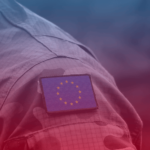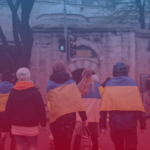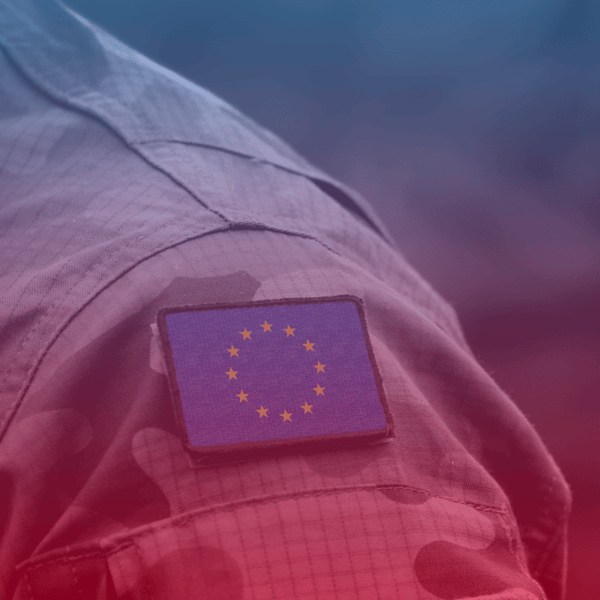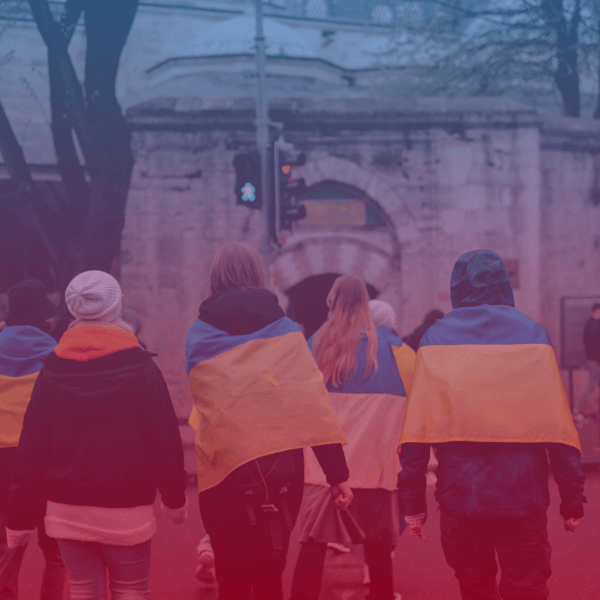
Written by Carla Posch
Introduction
This past month has marked one year of war in Ukraine. The following article will highlight what has been the reality for Ukrainian parents and children for 12 months: After 2 years of a pandemic, education in Ukraine continues to be disrupted. School education is often one of the first services given up in armed conflict and war. This happens for many reasons – parents fear for their children’s safety outside of the confines of their homes, schools are destroyed or damaged due to bombings or shelling, and, nowadays, the possibility of online education makes the cancellation of formal school education seem relatively harmless. Moreover, due to the Russian attacks on the country’s energy infrastructure in November 2022, several blackouts have left 10 million families without electricity (Save the Children 2022), affecting online classes and children’s ability to do their homework.
Apart from studying, the social skills that children learn while in school are also significantly affected. Additionally, schools provide a safe haven, particularly in times of chaos. Therefore, armed conflict negatively affects children, their education and their future, resulting in long-term psychological and physical impediments (Cervantes-Duarte & Fernández-Caro, 2016).
There is a broad consensus on this as the international community is responsible for protecting children, as laid out in the United Nations Convention on the Rights of the Child (UNCRC). However, the war in Ukraine shows that states, governments and societies still do not do enough to protect the children’s right to education: As UNICEF reported in January 2023, the war in Ukraine disrupted education for more than five million children (United Nations News, 2023).
Thus, the following article will focus on what the European Union and its member states can do to mitigate the effects of armed conflict on Ukrainian children.
The article first gives an overview of the current education crisis in Ukraine and then further analyses the pedagogical, psychological, social and political consequences of the same while considering the applicable human rights instruments in each instance. Finally, the article will introduce policy options and recommendations to address the issue of children’s education in the face of armed conflict.
Education in Ukraine since February 2021
On January 24th, the world celebrated the 2023 International Day of Education. Ironically, the event was commemorated exactly one month before the anniversary of the Russian invasion of Ukraine. Over five million Ukrainian children’s education is disrupted by this war (United Nations News, 2023), therefore heavily impacting the universal right to education. There are various reasons why and how armed conflict affects children’s education.
The following few paragraphs will give an overview of the main mechanisms in the case of Ukraine. Firstly, educational institutions are often impacted by violent fighting, either being destroyed or damaged. According to Ukraine’s Ministry of Education and Science, “at least 1,888 schools were damaged and destroyed by shelling and bombing” (Save the Children, 2022) by June 2022. A Ukrainian state website that collects data on damaged properties stated that a total of 2638 educational institutions were damaged, and 437 of those were destroyed (Save the Schools, n.d.). A report by the Centre for Information Resilience, verified the shelling of 41 educational institutions by September 2022. The analysis suggested that these attacks were targeted (Centre for Information Resilience, 2022). The variation in numbers suggests that there are several cases that are yet unreported or undefined.
A consequence of this violence against civilian targets is that Ukrainian parents do not send their children to school out of fear. The parents’ fear of exposing their children to physical and mental harm reportedly outweighs the risk of missing out on education (World Vision, 2022).
Besides the physical destruction of buildings, the attacks on the Ukrainian energy infrastructure leave families and children without electricity – on top of the basic need for heating, this additionally disrupts the children’s ability to do their homework or attend online courses. Growing energy needs made it necessary for humanitarian organisations to deliver generators for hospitals, collective centres, and schools (United Nations Office for the Coordination of Humanitarian Affairs, 2022).
However, not only those still physically in conflict zones experience difficulties: Those children whose families sought refuge in other countries often also have trouble accessing education. While EU countries quickly granted Ukrainian children access to their education system (United Nations Educational, Scientific and Cultural Organization (UNESCO), 2022), reports say that two-thirds of those children are still not going to school in their host country (United Nations News, 2023). This does not come as a surprise for many experts who call this period of settling into a new environment ‘secondary trauma’ for refugees as children face new obstacles, such as a new language, a different culture, new peers and unknown authority figures (Haddad, Koyiet & Shaw, 2022).
In fact, it is not enough to merely get children back to formal schools. Armed conflict can have intense, long-lasting consequences for children, especially when they are still developing physically and psychologically. It has been widely documented that the long-term effects of armed conflict on children’s education are dependent on a variety of factors, such as the type of conflict, the individual’s gender, the type of experienced violence and the type of education that is analysed (Brück, Di Maio & Miaari, 2022). Short-term education loss can lead to unerasable gaps in children’s education and knowledge. This is true for both educational content and social interaction. As often the case for children in armed conflict, exposure to violence may also result in medical conditions such as an increased risk of chronic diseases such as diabetes, and chronic lung and cardiovascular diseases (Chiang et al., 2016).
The Human Right to Education
In terms of the human right to education specifically, there are several contexts in which the impact of armed conflict on education must be analysed, namely pedagogical, psychological, social, and political implications. The universal right to education for children is rooted in article 28 of the Convention on the Rights of the Child (UNCRC). It reads as follow:
“States Parties recognize the right of the child to education, and with a view to achieving this right progressively and on the basis of equal opportunity, they shall, in particular:
(a) Make primary education compulsory and available free to all;
(b) Encourage the development of different forms of secondary education, including general and vocational education, make them available and accessible to every child, and take appropriate measures such as the introduction of free education and offering financial assistance in case of need;
(c) Make higher education accessible to all on the basis of capacity by every appropriate means;
(d) Make educational and vocational information and guidance available and accessible to all children;
(e) Take measures to encourage regular attendance at schools and the reduction of drop-out rates.” (United Nations Convention on the Rights of the Child, 1989).
Article 13 of the International Covenant on Economic, Social and Cultural Rights (ICESCR) also stipulates the right to education. The United Nations has also mandated a Special Rapporteur on the Right to Education, presently Ms. Sharida Faheed, who is responsible for examining “the crucial issue of the right of all persons to access quality education without discrimination”, and for providing “recommendations to Governments and other stakeholders” (OCHR, n.d.).
In armed conflict, the most difficult yet most important points to implement are the availability and accessibility of education for all children while additionally ensuring regular school attendance. The following paragraph will explain why this is significant and what consequences the noncompliance with UNCRC can have for children.
The Consequences of Armed Conflict for Children’s Education
The pedagogical factors are probably the most obvious ones concerning education: Children experience a loss of skills due to the lack of education. While there may be different types of education in conflict-affected areas, the teaching staff is mostly under- or non-qualified in the face of displacement. Alongside that, there are concerns related to high death tolls and little to no training of new teachers (Bell & Huebler, 2011). This limits the possibility to conform to art. 28 (b) and (d) of the Convention on the Rights of the Child, with regards to the development of different forms of (secondary) education as well as the availability of education.
Psychologically, armed conflict and the associated experiences for young people result in different forms of trauma for the people on the ground. This has various behavioural consequences. Specifically, in terms of education, it could mean that a child refuses to return to school or education in general, as he or she has experienced traumatic events in a school environment, or he or she suffers under the stigma of being under-educated (Cervantes-Duarte & Fernández-Caro, 2016). This can also result in social isolation, as well as in the loss of the educational and protective function of schools. Therefore, compulsory education cannot be offered and is not adhered to in armed conflict, as laid out by art. 28 (a) UNCRC.
Overall, armed conflict additionally impacts academic communities and existing academic social networks (Cervantes-Duarte & Fernández-Caro, 2016). In a more political vein, stakeholders will invest less in the education sector at a time when priorities shift to military defence instead of social well-being. This, in turn, negatively impacts the region’s academic landscape long-term.
Recommendations
Altogether, the analysis underscores the various factors that play into the impact of armed conflict on children and their education – but what should have become clear is that, regardless of the specificities, armed conflict is always deconstructive for children’s education. Therefore, the core of the following recommendations is that violence and conflict should always be strictly prevented and/or mediated, as peace is the best prerequisite for prosperity, social inclusivity and fruitful learning environments.
In addition to this, there are three main policy recommendations to mediate and prevent the effects of armed conflict on children and their education:
- Strengthen international (humanitarian) law prohibiting attacks on civilian targets such as educational institutions. While this has been attempted through the unanimous United Nations Security Council (UNSC) Resolution 2601 (2021), the first-ever resolution explicitly dedicated to education, continuous monitoring of the situation on the ground is necessary as well as follow-ups to ensure that member states comply with the UNSC’s appeals.
- National Action Plans on how to ensure children’s continued education in the case of armed conflict. These should include detailed processes and responsibilities to ensure the prioritisation and protection of children, teachers, and education infrastructure.
- An international knowledge-sharing hub where students, teachers and parents can interact with each other to develop and share best-practice models for teaching and learning under difficult or life-threatening conditions.
Conclusion
In conclusion, education is a vital part of early development for children, not only in terms of learning skills but also in terms of psychological and social development. Therefore, it is of the utmost importance to facilitate adequate learning environments for children worldwide, regardless of their external conditions.
Armed conflict is one of the most extreme forms of disrupting children’s education as it does not merely interrupt the learning processes, but instead permanently traumatises young people to the point.
While armed conflict should always be prevented, a few things could facilitate better teaching and learning environments, namely a strong international legal framework, National Action Plans purely dedicated to establishing children’s education and, finally, the possibility to develop and share best practices globally. These three steps will contribute to a better-prepared educational system that can support and care for children in need.
References
Bell, S. & Huebler, F. (2011). The Quantitative Impact of Conflict on Education. Technical Paper No 7. UNESCO Institute for Statistics.
Brück, T., Di Maio, M. & Miaari, S. (2022). Learning the Hard Way: The Effect of Conflict on Education. In Garicano, L., Rohner, D. & Weder di Mauro, B. Global Economic Consequences of the War in Ukraine (pp. 175 – 180). Retrieved from https://cepr.org/system/files/2022-09/172987-global_economic_consequences_of_the_war_in_ukraine_sanctions_supply_chains_and_sustainability.pdf#page=185.
Centre for Information Resilience. (2022). The systematic targeting of educational infrastructure in Kharkiv. September 14, 2022. Retrieved from https://www.info-res.org/post/the-systematic-targeting-of-civilian-infrastructure-in-kharkiv-schools-and-educational-facilities.
Cervantes-Duarte, L. & Fernández-Cano, A. (2016). Impact of Armed Conflicts on Education and Educational Agents: A Multivocal Review. Educare Electronic Journal 20(3), pp. 1-24. Retrieved from http://www.una.ac.cr/educare.
Chiang, L.F., Kress, H., Sumner, S.A., et al. (2016). Violence Against Children Surveys (VACS): Towards a Global Surveillance System. Injury Prevention 22, pp. 17-22. http://dx.doi.org/10.1136/injuryprev-2015-041820.
Haddad, N., Koyiet, P. & Shaw, K. (2022). No Peace of Mind. The looming mental health crisis for the children of Ukraine. World Vision Report. Retrieved from https://www.wvi.org/sites/default/files/2022-07/No%20Peace%20of%20Mind.pdf.
International Covenant on Economic, Social and Cultural Rights, opened for signature 16 December 1966, 993 UNTS 3 (entered into force 3 January 1976). Retrieved from https://www.ohchr.org/sites/default/files/cescr.pdf.
OCHR. (n.d.). Special Rapporteur on the right to education. Retrieved from https://www.ohchr.org/en/special-procedures/sr-education.
Santos, S., Den Braber, M. & Agam Fusfus, G. (2022). The Systematic Targeting of Educational Infrastructure in Kharkiv. September 14, 2022. Retrieved from https://www.info-res.org/post/the-systematic-targeting-of-civilian-infrastructure-in-kharkiv-schools-and-educational-facilities.
Save The Children. (2022). Ukraine: More than half of children missing out on education due to blackouts – Survey. November 22, 2022. Retrieved from https://www.savethechildren.net/news/ukraine-more-half-children-missing-out-education-due-blackouts-survey.
Save the Schools. (n.d.). 7 Million Children of War in Ukraine. Retrieved from http://saveschools.in.ua/en/.
United Nations Convention on the Rights of the Child, opened for signature 20 November 1998, 1577 UNTS 3 (entered into force 2 September 1990). Retrieved from https://www.ohchr.org/sites/default/files/crc.pdf.
United Nations Educational, Scientific and Cultural Organization. (2022). Mapping host countries’ education responses to the influx of Ukrainian students. March 24, 2022. Retrieved from https://www.unesco.org/en/articles/mapping-host-countries-education-responses-influx-ukrainian-students?TSPD_101_R0=080713870fab2000b1bf3e5b52bf0a1022777345d86876272e224b6d415ffd0c20036dd6fab9ac2c08396f8850143000a0d798ff8646d4557f5d84bbe9e85320e57ec89e7e2006c1c94f25968bbdec71889686be09aab85dd995f3c561a1d964.
United Nations News. (2023). Ukraine war disrupts education for more than five million children: UNICEF. January 23, 2023. Retrieved from https://news.un.org/en/story/2023/01/1132757.
United Nations Office for the Coordination of Humanitarian Affairs. (2022). Ukraine, Situation Report, December 19, 2022. Retrieved from https://reports.unocha.org/en/country/ukraine/.
World Vision. (2022). Rapid Needs Assessment of Displaced Families in Chernivtsi, Ukraine. April 2022. Retrieved from https://www.wvi.org/sites/default/files/2022-07/FINAL%20Ukraine%20Rapid%20Needs%20Assessment%20Report_Final%20Summary.pdf.

 THE DIGITAL EURO: Unlocking its potential
THE DIGITAL EURO: Unlocking its potential  SAFE but Not Secure: The Challenge of a Common Defence and EU’s Unity
SAFE but Not Secure: The Challenge of a Common Defence and EU’s Unity  Blind Spots in AI Governance: Military AI and the EU’s Regulatory Oversight Gap
Blind Spots in AI Governance: Military AI and the EU’s Regulatory Oversight Gap  Selective Solidarity: The Desecuritisation of Migration in the EU’s Response to the Ukrainian Refugee Crisis
Selective Solidarity: The Desecuritisation of Migration in the EU’s Response to the Ukrainian Refugee Crisis 


